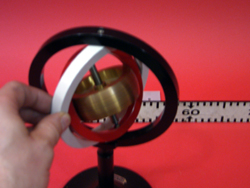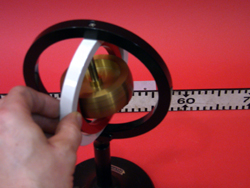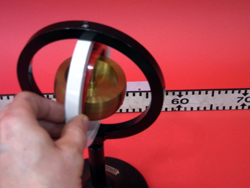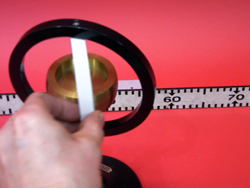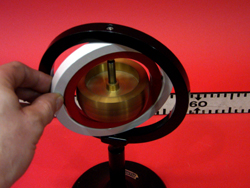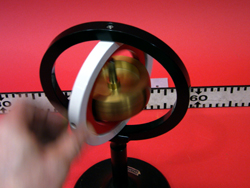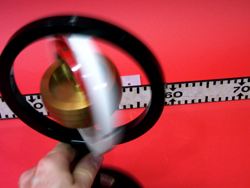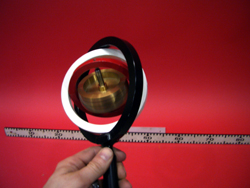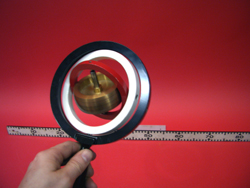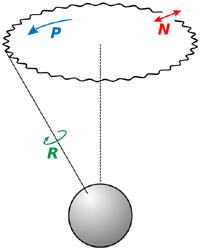|
Size: 1563
Comment:
|
← Revision 8 as of 2013-07-12 18:17:57 ⇥
Size: 3458
Comment: converted to 1.6 markup
|
| Deletions are marked like this. | Additions are marked like this. |
| Line 2: | Line 2: |
| ||<:30%>[:PiraScheme#Mechanics: Table of Mechanics Demonstration]||<:30%>[:MEEquipmentList: List of Mechanics Equipment & Supplies]||<:30%>[:Demonstrations:Lecture Demonstrations]|| | ||<:30%>[[PiraScheme#Mechanics| Table of Mechanics Demonstration]]||<:30%>[[MEEquipmentList| List of Mechanics Equipment & Supplies]]||<:30%>[[Demonstrations|Lecture Demonstrations]]|| |
| Line 4: | Line 4: |
| = Simple Gyroscope, 1Q50.05 = | = Simple Gyroscope, 1Q50.35 = |
| Line 7: | Line 7: |
| Rotational Dynamics, [:RotationalDynamics#Gyro: 1Q50. Gyroscopic Motion] | Rotational Dynamics, [[RotationalDynamics#Gyros| 1Q50. Gyroscopic Motion]] |
| Line 10: | Line 10: |
| * '''Cabinet:''' [:MechanicsCabinet:Mechanic (ME)] * '''Bay:''' [:MechanicsCabinetBayA12:(A12)] |
* '''Cabinet:''' [[MechanicsCabinet|Mechanic (ME)]] * '''Bay:''' [[MechanicsCabinetBayA12|(A12)]] |
| Line 14: | Line 14: |
| attachment: mainPhoto | {{attachment:SimpleGryo01-400.jpg}} |
| Line 18: | Line 18: |
| Insert succinct description of demonstration. | A tabletop gyroscope with three degrees of freedom shows gyroscopic motion. It can be carried around or put on a turntable. |
| Line 22: | Line 22: |
| ||apparatus||[:MechanicsCabinetBayB1: ME, Bay B1, Shelf #2]|| || ||all other parts||[:MechanicsCabinetBayB1: ME, Bay B1, Shelf #2]|| || ||...||[:MechanicsCabinetBayA5: ME, Bay A5, Shelf #2]|| || |
||Table Gyroscopes||[[MechanicsCabinetBayA12| ME, Bay A12, Shelf #1]]|| || ||Electric Driver||[[MechanicsCabinetBayA12| ME, Bay A12, Shelf #1]]|| || |
| Line 28: | Line 27: |
| * ''''' ''''' | * N/A |
| Line 33: | Line 32: |
| 1. List steps for setup then procedure. 1. ... |
1. Place gyroscope on lecture bench. 1. Plug in the electric driver (pictured below). 1. Using the electric driver, accelerate the disc to high speed. 1. Perturb the gyroscope (some ways of doing so are picture below). This can be done by giving a quick push to one of the (red/white) free rings or by picking it up by the stem and moving it around with your hand. One other way of doing this would be to place it on a turntable and set the turntable into motion. |
| Line 37: | Line 39: |
| * | * N/A |
| Line 42: | Line 44: |
| Discuss the physics behind the demonstration, explaining some of the various steps of the demonstration when appropriate. | Once the disc is accelerated, it has some amount of angular momentum which is a conserved quantity provided that there exists no net torque on the disc. When one tries to perturb the rotational motion of the disc, the axis of rotation of the disc tends to remain near its original position ("attempting" to conserve its angular momentum). This wobble is a combination of two effects: nutation and precession. Nutation is essentially a wobble of the axis of rotation toward and away from the original axis. Precession is the rotation of the new axis of rotation around the original axis. These are shown in the graphic below. |
| Line 44: | Line 46: |
| ||attachment: photo||attachment: photo||attachment: photo||attachment: photo|| | ||{{attachment:SimpleGryo02-250.jpg}}||{{attachment:SimpleGryo03-250.jpg}}||{{attachment:SimpleGryo04-250.jpg}}||{{attachment:SimpleGryo05-250.jpg}}|| ||{{attachment:SimpleGryo06-250.jpg}}||{{attachment:SimpleGryo07-250.jpg}}||{{attachment:SimpleGryo08-250.jpg}}||{{attachment:SimpleGryo09-250.jpg}}|| ||{{attachment:SimpleGryo10-250.jpg}}||{{attachment:SimpleGryo11-250.jpg}}||{{attachment:SimpleGryo12-250.jpg}}||{{attachment:SimpleGryo13-250.jpg}}|| ||{{attachment:SimpleGryo14-250.jpg}}||{{attachment:SimpleGryo15-250.jpg}}||{{attachment:SimpleGryo16-250.jpg}}||{{attachment:SimpleGryo17-250.jpg}}|| ||{{attachment:SimpleGryo18-250.jpg}}||{{attachment:SimpleGyro19-250.jpg}}||{{attachment:PrecessionNutation-250.png}}|| |
| Line 47: | Line 53: |
| * [https://www.youtube.com/user/LectureDemostrations/videos?view=1 Lecture Demonstration's Youtube Channel] | * [[https://www.youtube.com/user/LectureDemostrations/videos?view=1|Lecture Demonstration's Youtube Channel]] |
| Line 51: | Line 57: |
| * List any references | * [[https://en.wikipedia.org/wiki/Gyroscope|Wikipedia - Gyroscope]] * [[https://en.wikipedia.org/wiki/Angular_momentum|Wikipedia - Angular Momentum]] * [[https://en.wikipedia.org/wiki/Nutation|Wikipedia - Nutation]] * [[https://en.wikipedia.org/wiki/Precession|Wikipedia - Precession]] |
| Line 54: | Line 63: |
| [:Instructional:Home] | [[Instructional|Home]] |
Simple Gyroscope, 1Q50.35
Topic and Concept:
Rotational Dynamics, 1Q50. Gyroscopic Motion
Location:
Cabinet: Mechanic (ME)
Bay: (A12)
Shelf: #1
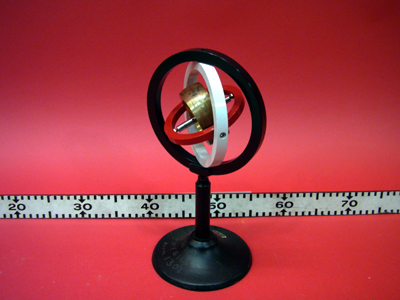
Abstract:
A tabletop gyroscope with three degrees of freedom shows gyroscopic motion. It can be carried around or put on a turntable.
Equipment |
Location |
ID Number |
|
|
|
Table Gyroscopes |
|
|
Electric Driver |
|
Important Setup Notes:
- N/A
Setup and Procedure:
- Place gyroscope on lecture bench.
- Plug in the electric driver (pictured below).
- Using the electric driver, accelerate the disc to high speed.
- Perturb the gyroscope (some ways of doing so are picture below). This can be done by giving a quick push to one of the (red/white) free rings or by picking it up by the stem and moving it around with your hand. One other way of doing this would be to place it on a turntable and set the turntable into motion.
Cautions, Warnings, or Safety Concerns:
- N/A
Discussion:
Once the disc is accelerated, it has some amount of angular momentum which is a conserved quantity provided that there exists no net torque on the disc. When one tries to perturb the rotational motion of the disc, the axis of rotation of the disc tends to remain near its original position ("attempting" to conserve its angular momentum). This wobble is a combination of two effects: nutation and precession. Nutation is essentially a wobble of the axis of rotation toward and away from the original axis. Precession is the rotation of the new axis of rotation around the original axis. These are shown in the graphic below.
|
|
|
|
|
|
|
|
|
|
|
|
|
|
|
|
|
|
|
Videos:
References:


